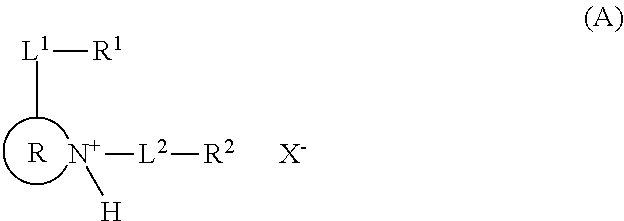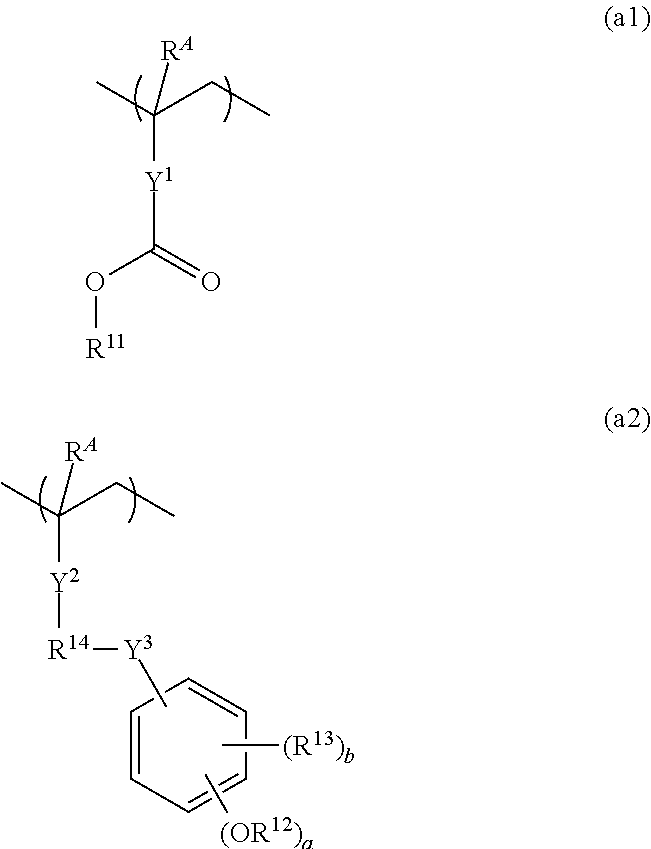Resist composition and patterning process
a composition and composition technology, applied in the field of resist composition and pattern forming process, can solve the problems of reducing the resolution and focus margin of hole and trench pattern, low acid diffusion control ability, and previous photoresist cannot accommodate the requirements, etc., to achieve low acid diffusion, suppress acid diffusion, and high sensitivity
- Summary
- Abstract
- Description
- Claims
- Application Information
AI Technical Summary
Benefits of technology
Problems solved by technology
Method used
Image
Examples
synthesis example 1-1
[0190]Synthesis of Quencher Q-1
(1) Synthesis of Intermediate In-1
[0191]
[0192]In nitrogen atmosphere, a flask in an ice bath was charged with 5.0 g of 4-(2-hydroxyethyl)morpholine and 100 g of methylene chloride, to which 11.4 g of trifluoroacetic acid was added dropwise. At the end of addition, the reaction system was warmed up to room temperature and aged for 17 hours. At the end of aging, the solvent and the excess of trifluoroacetic acid were distilled off, leaving a fluorinated cyclic amine compound (Intermediate In-1) as oily matter (amount 8.7 g, yield 100%).
(2) Synthesis of Quencher Q-1
[0193]
[0194]In nitrogen atmosphere, a flask was charged with 1.0 g of Intermediate In-1, 2.2 g of 2,3,5-triiodobenzoic acid, and 5 g of tetrahydrofuran (THF), which were stirred at room temperature for 30 minutes. The solvent was distilled off, leaving Quencher Q-1 as solids (amount 3.3 g, yield 100%).
[0195]Quencher Q-1 was analyzed by IR spectroscopy and TOF-MS, with the results shown below. F...
synthesis examples 1-2 to 1-35
[0198]Synthesis of Quenchers Q-2 to Q-35
[0199]Quenchers Q-2 to Q-35 were synthesized as in Synthesis Example 1-1 by mixing a fluorinated cyclic amine compound with a carboxylic acid compound, sulfonamide compound, halogenated phenol compound or hydrogen halide compound in a molar ratio of 1:1. Quenchers Q-1 to Q-35 have the structure shown below.
synthesis examples 2-4 to 2-4
[0200]Synthesis of base polymers (Polymers P-1 to P-4)
[0201]Base polymers (Polymers P-1 to P-4) were prepared by combining suitable monomers, effecting copolymerization reaction thereof in THF solvent, pouring the reaction solution into methanol for crystallization, repeatedly washing the solid precipitate with hexane, isolation, and drying. The resulting polymers were analyzed for composition by 1H-NMR spectroscopy, and for Mw and Mw / Mn by GPC versus polystyrene standards using THF solvent.
PUM
| Property | Measurement | Unit |
|---|---|---|
| wavelength | aaaaa | aaaaa |
| wavelength | aaaaa | aaaaa |
| wavelength | aaaaa | aaaaa |
Abstract
Description
Claims
Application Information
 Login to View More
Login to View More - R&D
- Intellectual Property
- Life Sciences
- Materials
- Tech Scout
- Unparalleled Data Quality
- Higher Quality Content
- 60% Fewer Hallucinations
Browse by: Latest US Patents, China's latest patents, Technical Efficacy Thesaurus, Application Domain, Technology Topic, Popular Technical Reports.
© 2025 PatSnap. All rights reserved.Legal|Privacy policy|Modern Slavery Act Transparency Statement|Sitemap|About US| Contact US: help@patsnap.com



